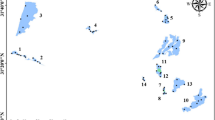Abstract
We collected the common fish species in all available aquatic habitats (streams, oxbow lakes, swamps) in bottomlands of McCurtain County, Oklahoma. Abundance and distribution of fishes, and environmental data were analyzed by a multivariate approach and examined for fit to a hierarchical model. The variables maximum depth, substrate, and presence of flow were the most important variables predicting fish community structure. Our multivariate analyses demonstrate that environmental factors can explain much variation in presence and abundance of the common fish species. Kolasa's hierarchical model relates species to each other by comparing ranges. This habitat-based model explained the relationships of our species ranges.
Similar content being viewed by others
References
Andrewartha, H. G. & L. C. Birch, 1954. The distribution and abundance of animals. University of Chicago Press, Chicago: 782 pp.
Brown, J. H., 1984. On the relationship between abundance and distribution of species. Am. Nat. 122: 295–299.
Capone, T. A. & J. A. Kushlan, 1991. Fish community structure in dryseason stream pools. Ecology 72: 983–992.
Crowl, T. A. & G. D. Schnell, 1990. Factors determining population density and size distribution of a freshwater snail in streams: effects of spatial scale. Oikos 59: 359–367.
Echelle, A. A. & G. D. Schnell, 1976. Factor analysis of species associations among fishes of the Kiamichi River, Oklahoma. Trans. am. Fish. Soc. 1: 17–31.
Felley, J. D. & S. M. Felley, 1987. Relationships between habitat selection by individuals of a species and patterns of habitat segregation among species: fishes of the Calcasieu drainage. In W. J. Matthews and D. C. Heins (eds), Community and Evolutionary Ecology of North American Stream Fishes. University of Oklahoma Press, Norman: 310 pp.
Finger, T. R. & E. Stewart, 1987. Responses of fishes to flooding regime in lowland hardwood wetlands. In W. J. Matthews and D. C. Heins (eds), Community and Evolutionary Ecology of North American Stream Fishes. University of Oklahoma Press, Norman: 310 pp.
Gaston, K. J., 1990. Patterns in the geographical ranges of species. Biol. Rev. 65: 105–129.
Gauch, H. G., Jr., 1982. Multivariate analysis in community ecology. Cambridge University Press, Cambridge: 298 pp.
Gotelli, N. J. & D. Simberloff, 1987. The distribution and abundance of tallgrass prairie plants: a test of the coresatellite hypothesis. Am. Nat. 130: 18–35.
Hanski, L., 1982. Dynamics of regional distribution: the core and satellite species hypothesis. Oikos 38: 210–221.
Hill, M. O., 1979. TWINSPAN — a fortran program for arranging multivariate data in an ordered two-way table by classification of the individuals and attributes. Section of Ecology and Systematics, Cornell University, Ithaca: 90 pp.
Kolasa, J., 1989. Ecological systems in hierarchical perspective: breaks in community structure and other consequences. Ecology 70: 36–47.
Krebs, C. J., 1985. Ecology: the Experimental Analysis of Distribution and Abundance. Harper and Row, New York: 800 pp.
Lee, D. S., C. R. Gilbert, C. H. Hocutt, R. E. Jenkins, D. E. McAllister & J. R. Stauffer, Jr., 1980. Atlas of North American Freshwater Fishes. North Carolina State Museum, Raleigh: 867 pp.
Matthews, W. J., 1985. Distribution of midwestern fishes on multivariate environmental gradients, with emphasis on Notropis lutrensis. Am. Midl. Nat. 113: 225–237.
Matthews, W. J., 1990. Fish community structure and stability in warmwater midwestern streams. Biol. Report 90: 16–17.
Matthews, W. J. & H. W. Robison, 1988. The distribution of the fishes of Arkansas: a multivariate analysis. Copeia 1988: 358–374.
Preston, F. W., 1962. The canonical distribution of commonness and rarity. Ecology 61: 88–97.
Robison, H. W. & T. M. Buchanan, 1988. Fishes of Arkansas. The University of Arkansas Press, Fayetteville, Arkansas: 536 pp.
Secor, S. M. & G. D. Schnell, 1985. Evaluation of wetland habitats in Oklahoma's Gulf Coastal Plain. Report to the Nongame Program of the Oklahoma Department of Wildlife Conservation, Oklahoma City, Oklahoma.
Smith, C. L. & C. R. Powell, 1971. The summer fish communities of Brier Creek, Marshall County, Oklahoma. Am. Mus. Novit. 2458: 1–30.
Taylor, C. M., M. R. Winston & W. J. Matthews, 1992. Fish species-environment and abundance relationships in a great plains river system. Ecography (in press).
Ter Braak, C. J. F., 1986. Canonical correspondence analysis: a new eigenvector technique for multivariate direct gradient analysis. Ecology 67: 1167–1179.
Author information
Authors and Affiliations
Rights and permissions
About this article
Cite this article
Pyron, M., Taylor, C.M. Fish community structure of Oklahoma gulf coastal plains. Hydrobiologia 257, 29–35 (1993). https://doi.org/10.1007/BF00013994
Received:
Revised:
Accepted:
Issue Date:
DOI: https://doi.org/10.1007/BF00013994




